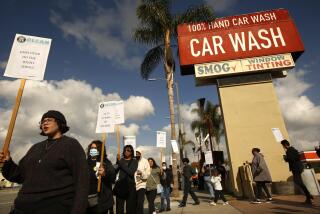Burbank’s solar-powered hangar sets a green example
Call it the ultimate plug-in recharger.
A team of Southern California developers today is taking the wraps off what may be the world’s greenest aviation facility, one capable of powering a Boeing 757 with solar energy while the aircraft is on the ground for maintenance.
The new 60,000-square-foot structure at Bob Hope Airport in Burbank is believed to be the industry’s only solar-powered airport hangar. Its rooftop photovoltaic panels provide enough juice to operate the building’s lights and to recharge electric-powered ground equipment such as forklifts and tow vehicles. The array can also keep an airplane’s electrical system humming inside the hangar while mechanics perform their chores.
Green construction and solar-powered buildings are nothing new in California. Still, the Burbank facility, known as Hangar 25, appears to be a clean step forward for the aviation industry, which has a massive carbon footprint.
“I haven’t heard of anything like it before,” said Steve Howards, executive director of the Clean Airport Partnership, a nonprofit based in Lakewood, Colo., that promotes energy efficiency and sustainability at U.S. airports. “A facility that generates enough renewable power to support [aircraft] maintenance equipment? That’s a precedent setter.”
The $17-million hangar is a joint venture involving Shangri-La Construction of Century City, aviation services company Avjet Corp. of Burbank and the Burbank-Glendale-Pasadena Airport Authority, which owns and operates Bob Hope Airport.
The project is the first for Shangri-La Construction, a new player on the green construction scene. But its founder, Steve Bing, is well known in Los Angeles circles as a film producer, philanthropist and heir to a real estate fortune.
Hangar 25 is among only a handful of Southern California buildings to obtain so-called LEED Platinum status. That’s the highest environmentally friendly rating given by the U.S. Green Building Council. In addition to solar power, the structure’s features include drought-tolerant landscaping, water-stingy plumbing, nontoxic building materials and lots of glass to illuminate rooms with natural sunlight.
Buildings are one of the largest contributors to global warming because of the massive amounts of energy needed to heat, light and cool them. Environmentalists are urging better construction practices to improve efficiency.
Green structures typically cost more to build than conventional ones, but the payback comes through energy savings. That’s good for the planet and owners’ pocketbooks, said Andy Meyers, president of Shangri-La Construction, who said Hangar 25 didn’t cost significantly more than a traditional facility.
“The bottom line of green is black,” said Meyers, a former football standout at UCLA. “It’s cheaper to operate.”
Well-designed buildings tend to be friendly to workers as well as the environment. Bruce Vogt is chief of maintenance for the Boeing business jets that Avjet will service at the new Burbank facility. He said he liked the building’s natural lighting and the quiet provided by the electric-powered equipment.
“Hangars are usually dark and dank,” he said. “This is a lot better than the old way.”
Whether Hangar 25 spawns many imitators remains to be seen. Most of the emissions at U.S. airports come from airplanes and vehicles, not buildings. Making enormous passenger terminals sustainable is a lot tougher than greening a modest-size maintenance hangar.
Still, Howards said, airport authorities nationwide are looking to cut operating costs and reduce their emissions where they can.
“These smaller-scale projects are the springboard for a large-scale evolution,” he said.
--






